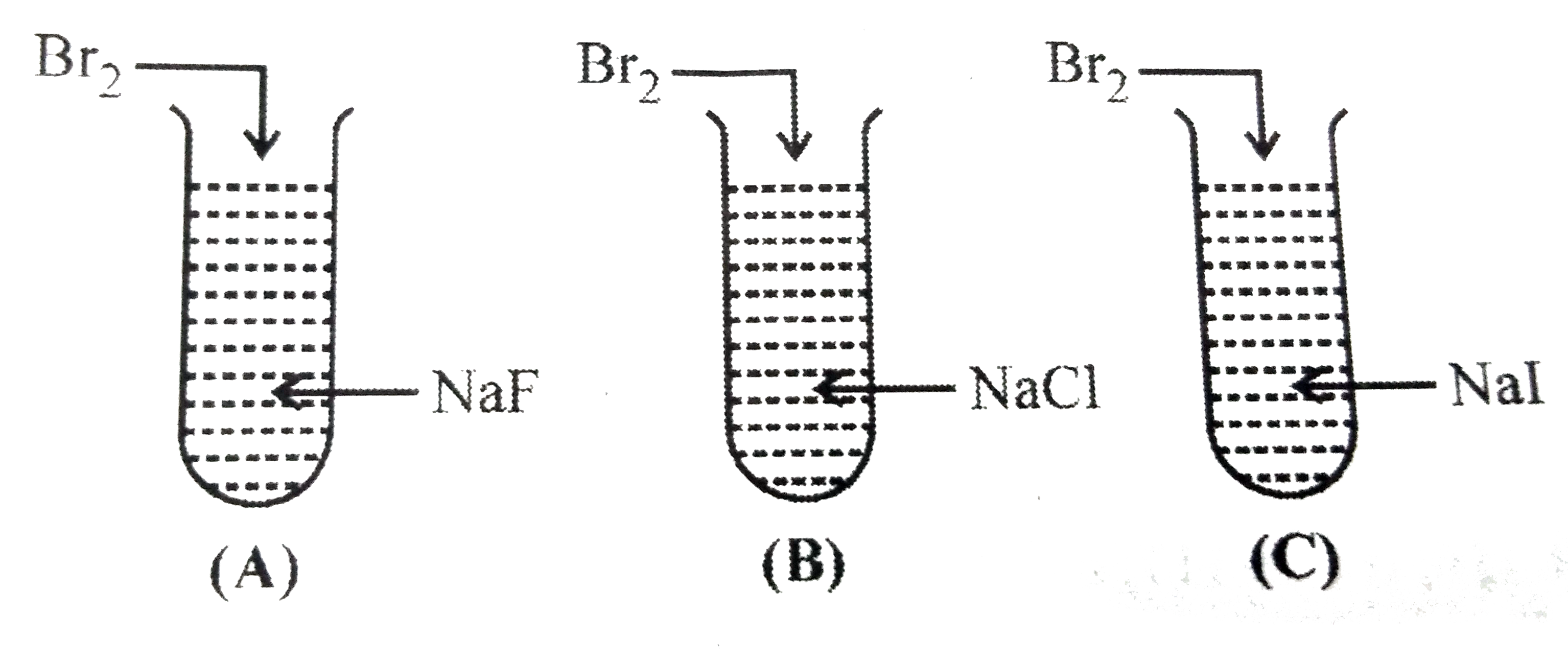When Br2 is treated with aqueous solutions of NaF, NaCl and NaI separately
F2,Cl2 and I2 are liberated
Only F2 and Cl2 are liberated
Only I2 is liberated
Only Cl2 is liberated
The correct Answer is:C
To solve the problem of what happens when Br2 is treated with aqueous solutions of NaF, NaCl, and NaI separately, we need to consider the reactivity of bromine with these halide ions.
Step 1: Understanding the Reactivity of Halogens
Halogens are known to exhibit a trend in reactivity. In general, a more reactive halogen can displace a less reactive halogen from its compound. The reactivity trend of halogens is as follows:
F>Cl>Br>I
Step 2: Reaction of Br2 with NaF
When Br2 is treated with NaF:
- Bromine (Br2) is less reactive than fluorine (F2).
- Therefore, bromine cannot displace fluorine from sodium fluoride.
- No reaction occurs.
Result: No reaction with NaF.
Step 3: Reaction of Br2 with NaCl
When Br2 is treated with NaCl:
- Bromine is more reactive than chlorine.
- Thus, bromine can displace chlorine from sodium chloride.
- The reaction can be represented as:
Br2+2NaCl→2NaBr+Cl2
Result: Cl2 is produced, and NaBr is formed.
Step 4: Reaction of Br2 with NaI
When Br2 is treated with NaI:
- Bromine is less reactive than iodine.
- Therefore, bromine cannot displace iodine from sodium iodide.
- No reaction occurs.
Result: No reaction with NaI.
Summary of Reactions:
1. With NaF: No reaction.
2. With NaCl: Reaction occurs, producing NaBr and Cl2.
3. With NaI: No reaction.
Final Answer:
- Br2+NaF → No reaction
- Br2+NaCl → 2NaBr+Cl2
- Br2+NaI → No reaction
Halogens are known to exhibit a trend in reactivity. In general, a more reactive halogen can displace a less reactive halogen from its compound. The reactivity trend of halogens is as follows:
F>Cl>Br>I
When Br2 is treated with NaF:
- Bromine (Br2) is less reactive than fluorine (F2).
- Therefore, bromine cannot displace fluorine from sodium fluoride.
- No reaction occurs.
When Br2 is treated with NaCl:
- Bromine is more reactive than chlorine.
- Thus, bromine can displace chlorine from sodium chloride.
- The reaction can be represented as:
Br2+2NaCl→2NaBr+Cl2
When Br2 is treated with NaI:
- Bromine is less reactive than iodine.
- Therefore, bromine cannot displace iodine from sodium iodide.
- No reaction occurs.
1. With NaF: No reaction.
2. With NaCl: Reaction occurs, producing NaBr and Cl2.
3. With NaI: No reaction.
- Br2+NaF → No reaction
- Br2+NaCl → 2NaBr+Cl2
- Br2+NaI → No reaction
Topper's Solved these Questions
- BOOK - ERRORLESS CHAPTER - S AND P BLOCK ELEMENTSEXERCISE - Ordinary thinking (Nobal gases)69videos
S AND P BLOCK ELEMENTS
- BOOK - ERRORLESS CHAPTER - S AND P BLOCK ELEMENTSEXERCISE - Critical thinking (Objective Questions)62videos
S AND P BLOCK ELEMENTS
- BOOK - ERRORLESS CHAPTER - S AND P BLOCK ELEMENTSEXERCISE - Ordinary thinking (Oxygen family)109videos
S AND P BLOCK ELEMENTS
- BOOK - ERRORLESS CHAPTER - Practical Organic ChemistryEXERCISE - JEE Ssection (More than one choice correct answer)16videos
Practical Organic Chemistry
- BOOK - ERRORLESS CHAPTER - SOLID STATE EXERCISE - JEE section (Numeric )1videos
SOLID STATE
Similar Questions
Knowledge Check
- Question 1 - Select One
When Br2 is treated with aqueous solutions of NaF, NaCl and NaI separately
AF2,Cl2andI2 are liberatedBOnly F2andCl2 are liberatedConly I2 is liberatedDonly Cl2 is liberated - Question 2 - Select One
An aqueous solution of NaCl is
AacidicBbasicCneutralDeither acidic/basic - Question 3 - Select One
When iodine is passed through aqueous solutions of NaF, NaBr and NaCl
AIt gives mixture of F2,Cl2andBr2BIt gives chlorineCIt gives bromineDNone of these
When NaCl is added to aqueous solution of glucose
View SolutionAn aqueous solution of NaCl shall boil at
View SolutionAqueous solution of NaCl is neutral because
View SolutionWhich one is the correct observation when Br2 is treated with NaF, NaCl and NaI taken in three test tubes labelled as (I), (II) and (III) ?
View SolutionpH of an aqueous solution of NaCl at 85∘C should be
View Solution


